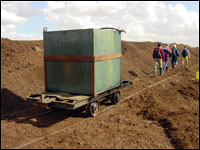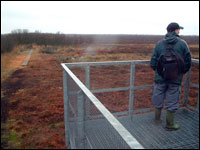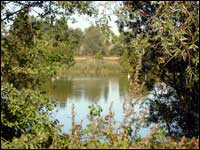The information presented is there to be used and enjoyed but please be sure to
acknowledge the source and author if you use any material.

Humberhead Peatlands
Thorne & Hatfield Moors / Picture Gallery.
INTRODUCTION
Thorne and Hatfield Moors form the largest complex of lowland raised bog in Britain covering an area of almost 8000 acres. Though the vast majority of the area is recently worked or abandoned peat cutting, this unique environment is rich in flora and fauna.
For some years a large area of the abandoned peat workings on Thorne Moors has been managed as a National Nature Reserve by Natural England, together with parts of Crowle Moor owned and managed by The Lincolnshire Trust for Nature Conservation but large areas of both Hatfield and Thorne Moors were still being heavily worked for peat. However in a bold move in 2001 the Government bought out the Peat Company Scotts - the largest manufacturer of horticultural projects in the world for £17.5m. There was an agreement drawn up for the last three seasons of working on the Moors and the last peat was cut in September 2004.
The oldest rocks proved by boreholes on the Moors are the Carboniferous Coal Measures Series. These are at the surface in West Yorkshire but by Hatfield and Thorne Colliery are at depths of 700m, approaching the limit of deep mining due to temperature. These rocks were laid down in warm tropical conditions but then the climate got drier and hotter so the Bunter Sandstone was laid down in. This is the soft reddish sandstone which is very permeable and water bearing and a number of the local boreholes harness this for drinking water. These rocks are overlain by the chalky mudstones of the Keeper Marl, the boundary running north-south across Thorne moors.
After the last glaciation a large lake formed - Lake Humber - within which clay formed to provide a seal above the underlying bedrock. As the ice melted sea levels tended to rise and rivers spread over the land depositing more silt and clay. The poor drainage allowed peat to get a get a foothold in the form mainly of Sphagnum Moss. Peat is like a sponge retaining water. Because of the surrounding high water the peat builds up to form a dome - hence lowland raised bog.
The raised bog was originally heavily wooded – mainly with birch and also large oaks - bog oaks are commonly found at the base of the peat.
In the earliest times the Moors would have been a valuable resource for fishing and hunting with little or no peat cutting as they were covered with woodland which provided fuel. The marshes would have been difficult to cross so trackways were constructed using-timber and these have been found and dated to over 3000 years old The tannin in he peat is an excellent preservative. Other artifacts of interest have been discovered – probably the most spectacular being a body of a Bronze age person – Lindow Man.
In more recent times peat was dug by local people as fuel for fires, and by the mid 19th Century, extensively for horses and cattle litter. One of the companies operating on Thorne Moors at this time, the Dutch Moss Litter Company, transported peat by horse-drawn barges along a network of canals to a mill near Moorends. The chequerboard appearance of cuttings and baulks can still be seen. This hand digging however was on a small scale so wildlife and plants could survive on the baulks between. Also the depth was such that the sphagnum moss could regenerate.
Modern peat cutting was for horticultural use and is a large scale operation involving construction plant planing off the layer of material over a vast area and heaping it up to dry. Also large drainage ditches are cut to lower the water table. This gives us the "moonscape" present today over large areas of Thorne and Hatfield Moors.
Another poignant reminder of the past are a number of aircraft wrecks that are scattered over the moor.
The abandoned peat cuttings, where sufficiently wet, have reverted back to bog. This ideal habitat provides a unique opportunity to see a range of special plants including common cottongrass, sphagnum mosses, cranberry, bog-rosemary and round leaved sundew. Cross leaved heath and hare's tail cotton grass grow in damp areas but the mush drier peat baulks support bracken, heather and birch. Areas of fen characterised by marsh cinquefoil, common reed and willow also occur.
Once used by horses and later by small trains pulling peat-laden wagons, the old tramways are built up of lime-rich ballast and clinker; here southern marsh orchid, twayblade, greater yellow rattle and bird's-foot trefoil can be found.
The varied habitat of the Moors also supports a huge number of invertebrates, with over 3000 recorded species, of which some are nationally rare. The area is a stronghold for the large heath butterfly, whose caterpillars feed on the cottongrass.
Breeding birds include common teal, common snipe, whinchat and tree pipit. The Rufus nightingale breeds in small numbers at its most northerly stronghold in Britain, whilst the size of the European nightjar population is of international importance. Wintering birds include hen harrier, merlin and short-eared owl.
Reptiles such as adder, grass snake and common lizard are present. Roe deer, fox, brown hare and water vole are some of the mammals which occur here.
 |
 |
 |
 |
 |
Before drainage and peat extraction took place, the Moors formed a raised bog. The aim of conservation management for the site is to retain suitable conditions for the development of raised bog and its vegetation. To maintain a high water table, drainage channels from the old peat cuttings have been blocked with peat dams. Water is also pumped into some recently worked out cuttings. On Crowle Moor, extensive areas have been cleared of invasive birch scrub and are now grazed by the Trust's flock of Hebridean sheep. These have also been based on Hatfield Moors in 2004.
But management for wildlife is one thing - what about access for the public - a possible conflict that has to be balanced.
Now that the Moors are largely in public ownership the attitude to public access is changing - now visitors are encouraged and "visitor management" needs to take place to balance the needs of all sorts of visitors with conservation. Issues: -
- walkers
- cyclists
- horse riders
- motorcycles
- 4 wheel drives
Consideration is being given to improving the access points to the moors and visitor centres are being planned.
The Humberhead Levels Green Tourism forum has devised a long distance footpath route which links various local settlements and includes the first permissive paths across Thorne and Hatfield Moors.
- The old peat workings and ditches contain deep water; these and saturated peat are very dangerous, so please keep to the mown routes. Adders are present, and midges and mosquitoes are plentiful during the summer months.
- Rewetted peat working and deep drains are dangerous.
- The lakes are deep and there are submerged objects - no swimming.
- Adders are found throughout the site - Do not touch. Adders may bite dogs.
- Dogs should be kept on a lead from March to July (under close control at all times) and at all times in the stock grazing compartments.
Environmentalists and others have long recognised the importance of finding alternatives to peat and labeling is being improved to identify low peat and peat free products to help consumers to make informed product choices. Unfortunately the idea that the entire horticulture industry could switch to peat-free products in the imminent future is just not realistic. At present there are simply insufficient alternatives to replace peat in the volumes required by consumers and professional growers.
If retailers can't get the consistent high quality product they need to meet the demand, they will simply use foreign supplies. Gardens like Kew, the Eden Project and the National Trust can go peat-free because they have the capacity to compost their own waste, and the skill and experience to understand that different growing regimes, watering and maintenance are needed for different growing media. Professional growers may not have this flexibility.
Ultimately, a balance needs to be struck. Pushing the price up could damage our highly competitive horticulture industry and dilution of growing media threatens the quality of plants and flowers in a business where quality is essential.
IRH
© Thorne Moorends Regeneration Partnership. All Rights Reserved.































